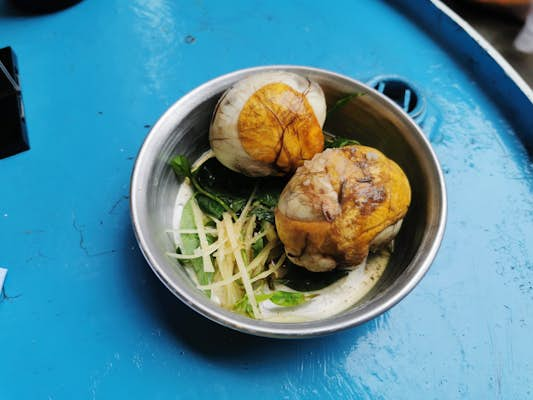What makes eating fun? Of course, there is the taste of the food. The smell and scent definitely make a difference as well. And, last but not least, it’s texture.
Think about it: where is the beauty of Hanoi’s noodle bowl? bun cha from? Sure, there are flavors: the smoky smell of roast pork and the sour hint of the broth. They are just perfectly in harmony. But most of all is the pleasant chewiness of the meatballs, the crispiness of the fresh lettuce and the richly marinated pieces of young mango and carrot. Overcook and you will spoil it.
The importance of texture in Vietnamese cooking traditions simply cannot be overestimated!
Enhancing sensation in the mouth
Vietnamese cuisine is about balance⇓—flavors, colors, nutrients, yin and yang. Its elements are meant to complement each other in every sense, and the mouthfeel takes center stage in this symphony. It’s the “flavor delivery mechanism,” as Californian restaurateur Daniel Patterson puts it.

Vietnamese rice cakes. Image source: eatwithroy.files.wordpress.com
Food is supposed to be as good as it tastes, and this is not done by mixing the same textures. Diversity isHey. When the ingredients are so similar in consistency, none of them stand out. Vietnamesethe namese chefs understood that.
For example, Central Vietnam is very fond of rice cakes. Why? Because they are crispy. John S. Allen, scientist at the Dornsife Cognitive Neuroscience Imaging Center and the Brain and Creativity Institute at the University of Southern California, statedhats all of us Crazy for crispy through evolutionary legacy. And can we refuse it?
In Central Vietnamese cuisine, the crispiness of rice cakes first and foremost contributes to an interesting combination of textures.
appropriately advertisementtagliatelle noodles stay firm, pork and/or (when in doubt, always choose ‘and’!) shrimp add a pungent flavour, greens and occasional peanuts for a crunchy, watery flavor It’s a bit thick – but it’s the rice crackers in it that round out the taste.
It wouldn’t be the same experience without them.
As Allen said, the crispiness of the rice cakes “enhanced[s] sensory experiences when eating” because they stimulate another sense associated with any eating experience: hearing. Take them out or let them soak in the broth and your delicious bowl will be half full.
Down with culinary stereotypes!
Western and Eastern cuisines clearly have different texture approaches. While creaminess is something you rarely find in Vietnamese food, no Western dish can beat Vietnamese stickiness. Case in point: sticky rice and mung bean paste.

Glutinous rice recipe with corn. Image source: vina.com
Most local desserts are based on the simple principle that sticky food makes you salivate in the truest sense of the word. But Vietnam would not be Vietnam without one more point of opposition. The toughness of green bean paste Orange cake (such as sesame balls), supplemented by deep frying the balls to create a crispy surface.

Orange cake. Image source: i2.wp.com
For the same reason, the classic Chinese New Year dish Chung cake (sticky rice cake) is best fried just before serving (and then dipped in salty soy sauce).
And not all Vietnamese tourists have tried it tofu watch eye data (tofu stuffed with meat and tomato sauce) Wonder how you can mix tofu and meat together? The answer is simple: you just have to give up your preconceptions about food combinations. As long as the elements form a harmonious whole (like soft tofu and firm meatballs), go ahead and combine!
This is a lesson learned from Vietnamese cuisine.
Puritans of the North, Laissez-Faire of the South
However, from North to South, Vietnamese people have a different, generally different approach to food. from puritan to “everything goes”. In the country’s capital, Hanoi, the dishes are simpler, with purer flavors. One Noodle Soup Beef broth with rice noodles and sliced beef. But the Hanoians also have small additions of texture, such as the sometimes crispy, sometimes soft fried bread sticks (bagel twists), and minced scallions.

Biscuit served with pho. Image source: nauzi.com
So here you have something that is obviously more varied in terms of texture, such as ketchup spaghetti.
However, the south and central parts of Vietnam are much more generous in terms of materials used. One Noodle Soup no greens is incomplete for a true Saigonese, and many would argue that the secret of Vietnamese cuisine lies in herbs. Of course, this is a biased statement that cannot help but come from a Southern soul. But it is true that this extravagance in cooking naturally produces more diverse compositions.
If I get bean sprouts with Noodle SoupI will definitely throw them in. For the sake of texture!
Finally, it has to be mentioned that the Vietnamese people’s slightly startling preference for… special textures. Any foreigner who has ever eaten a pot full of pork chops, with their smooth but hard-to-chew fat will know: Vietnamese like it slimy.
I mean, has anyone here tried a vintage wedding? ‘s site (crab soup) or be treated to bird’s nest (nests) by a Vietnamese friend of goodwill??

Crab soup. Image source: www.bepgiadinh.com
In my article about Vietnamese habits eat snailseat snails, Tom the word diver Coral Vietnam points to another locally beloved consistency — that of rubber. “One texture that is loved and popular by Vietnamese people for snails is the ‘tough-rubber’ texture. This is something most Westerners will have a hard time getting used to.”

Vietnamese s. Image source: pinterest.com
Correct. We are all prepped when it comes to food. Therefore, the first step to truly discovering Vietnamese cuisine is to surrender to the strange world of rarely felt textures.
